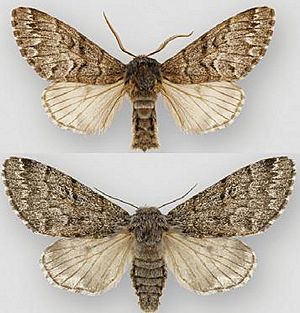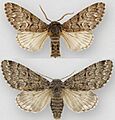Cascades panthea facts for kids
Quick facts for kids Cascades panthea |
|
|---|---|
 |
|
| Panthea virginarius male (top), female (bottom) | |
| Scientific classification |
The Panthea virginarius, also known as the Cascades panthea, is a type of moth. It belongs to a large family of moths called Noctuidae. This moth is mostly found in western and northern parts of North America.
You can spot the Cascades panthea along the coast of southern California. It lives all the way north to the Queen Charlotte Islands in British Columbia and the Alaskan Panhandle. Its range also extends eastward into central California, northern Nevada, Idaho, north-western Wyoming, western Montana, and south-western Alberta. There's even a separate group of these moths living in the Cypress Hills, which are located in Alberta and Saskatchewan.
Contents
Discovering the Cascades Panthea Moth
The Cascades panthea moth was first described by a scientist named Augustus Radcliffe Grote in 1880. Moths are fascinating insects that go through a complete metamorphosis. This means they change from an egg, to a larva (caterpillar), to a pupa, and finally to an adult moth.
What Does the Cascades Panthea Look Like?
These moths can look quite different from one another, even within the same species. They vary in both size and color. For example, some forms of this moth, like the angelica and portlandia forms, were once thought to be completely separate species. But scientists later discovered in 2009 that they are all part of the same Panthea virginarius species. This shows how much we can learn about nature over time!
Where Do These Moths Live?
The Cascades panthea moth prefers areas with lots of trees. They are commonly found in forests across their wide range in North America. Their habitat stretches from the Pacific Coast to parts of the Rocky Mountains.
What Do Cascades Panthea Caterpillars Eat?
The young moths, which are called larvae or caterpillars, have a specific diet. They mostly feed on the needles of Douglas fir trees. They also eat other types of conifer trees. These trees are very important for the caterpillars to grow and get enough energy.
Images for kids


